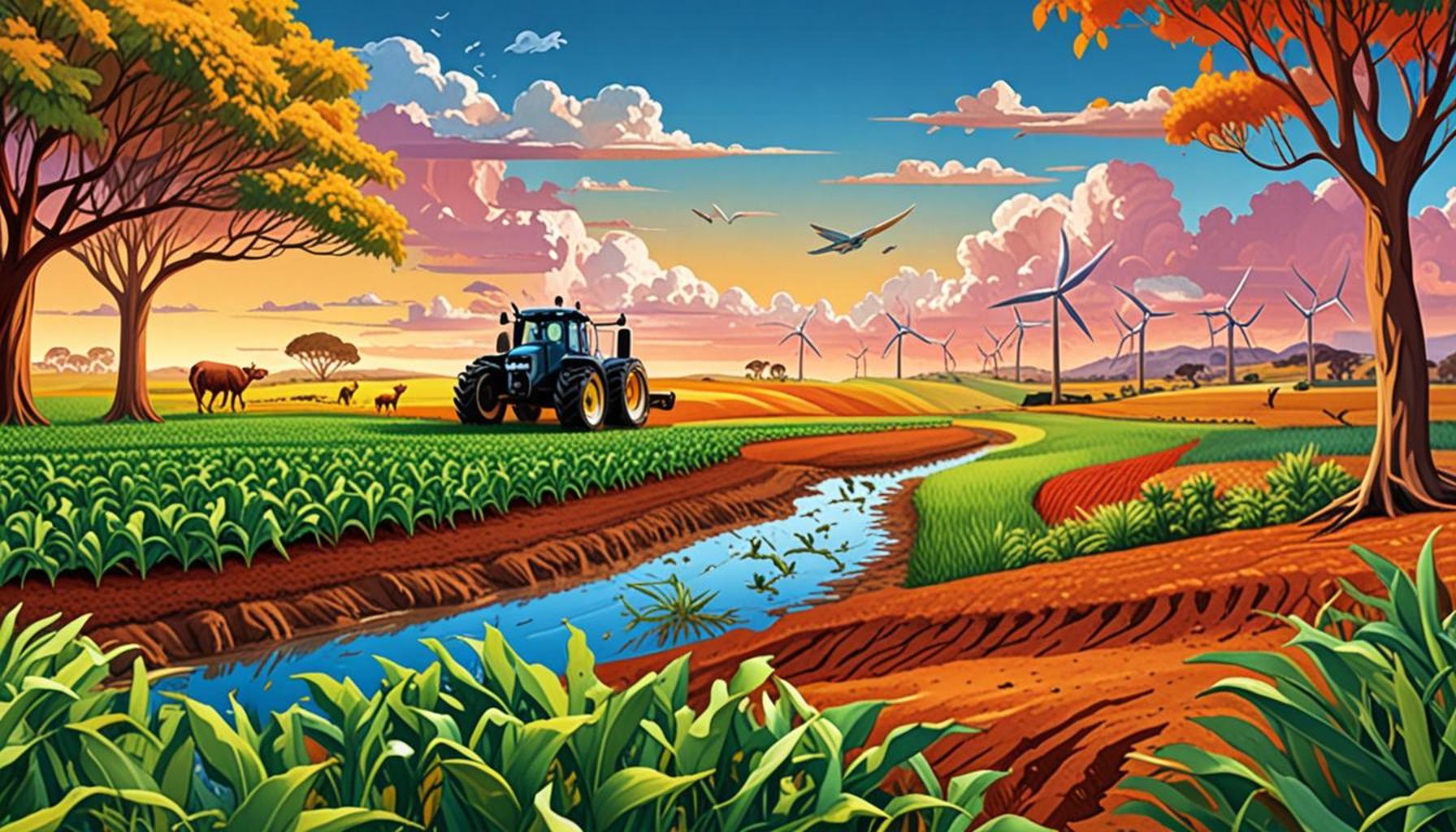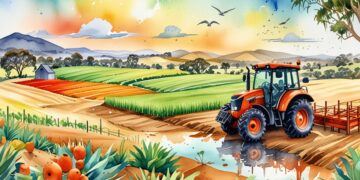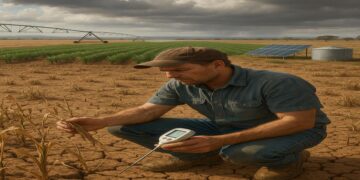The impact of climate change on Australia’s agricultural economy

Challenges Facing Australia’s Agricultural Sector
Australia’s agricultural sector is currently grappling with significant challenges that stem from climate change. The impacts of rising temperatures, shifting rainfall patterns, and more frequent extreme weather events are not only threatening farm productivity but also the sustainability of farming practices. It is essential for farmers, policymakers, and consumers to understand these multifaceted impacts in order to find effective solutions.
Key Effects of Climate Change on Agriculture
Climate change has direct effects on agricultural performance, compromising both crop yield and livestock health.
- Decreased crop yields: Staple crops such as wheat and barley are particularly vulnerable to heat stress caused by higher temperatures. For example, research has shown that a temperature increase of just two degrees Celsius can reduce wheat yields by up to 20%. This decline in productivity not only threatens food security but also affects farmers’ livelihoods.
- Increased pests and diseases: Warmer climates can lead to a surge in pests and diseases that adversely affect crops and livestock. For instance, the proliferation of fruit flies and other invasive pests can damage various crops, leading to increased pesticide use and raising both production costs and environmental concerns.
- Water scarcity: Altered rainfall patterns have resulted in prolonged droughts in many parts of Australia, such as New South Wales and Queensland. This not only reduces the available water for irrigation but also stresses existing water resources, creating competition among agricultural needs, urban usage, and ecological sustainability.
Economic Implications of Climate Change
The repercussions of climate change extend beyond agricultural productivity and seep into economic factors that affect the profitability and viability of farming.
- Price volatility: The inconsistencies in agricultural outputs can lead to significant fluctuations in prices. For instance, during drought years, the scarcity of products such as grains can drive prices up unexpectedly, making it challenging for consumers and impacting food affordability.
- Insurance costs: With the increased risk of natural disasters—such as bushfires and floods—many farmers are facing soaring insurance premiums, further straining their financial stability. This added burden can deter new farmers from entering the industry and increase the risk of existing farmers going out of business.
- Market access: As consumers increasingly prioritize sustainable farming practices, products that do not align with changing consumer preferences may struggle to find a market. Adapting to these demands can require additional investments in sustainable technologies and methods, which may not be feasible for all farmers.
Conclusion
In light of these challenges, Australia’s agricultural economy stands at a pivotal juncture. As climate change continues to impact the sector, it becomes imperative for farmers, industry leaders, and policymakers to collaborate on adapting practices and implementing innovative policies. By doing so, we can aim to create a sustainable future for Australian agriculture, ensuring that it can thrive amid these uncertainties.
Understanding the Effects of Climate Change on Farming Practices
The ramifications of climate change on Australia’s agricultural economy are profound and far-reaching. Farmers across the nation are increasingly aware that climate impacts are not isolated incidents but rather part of a broader trend that reshapes the way they cultivate crops and raise livestock. This understanding is crucial for developing adaptive strategies to mitigate these impacts.
Shifts in Crop Viability
The viability of crops that farmers traditionally relied on is shifting, forcing them to rethink what and how they grow. Changes in temperature and precipitation patterns are disrupting growing seasons, leading to mismatches between crop needs and environmental conditions.
- Adapting farming schedules: Farmers may have to change their planting and harvesting schedules to align with the altered climate. In some instances, crops may need to be sown earlier in the season, while others might require later planting. This added complexity can strain management resources.
- Diversity in crop selection: The need for diversification becomes more pronounced as certain traditional crops become less viable. Many farmers are investigating alternative crops that are more suited to the changing conditions, such as resilient varieties of sorghum or pulses that can thrive under warmer temperatures or less water.
- Soil health: Changes in rainfall frequency and intensity can also impact soil health. Increased erosion during heavy rainfalls or reduced moisture during dry spells can lead to nutrient depletion. Farmers are now focusing on sustainable farming practices like crop rotation and cover cropping to maintain soil integrity.
Impact on Livestock Production
The effects of climate change are not limited to crop production; they extend significantly into livestock farming as well. As temperatures rise, there are serious implications for animal health and productivity.
- Heat stress: Animals, particularly cattle and sheep, are vulnerable to heat stress, which can result in reduced feed intake, lower reproductive performance, and even increased mortality rates. Farmers are thus compelled to implement shade structures and provide adequate hydration to protect their livestock.
- Changing forage availability: Alterations in climate can also affect the growth of pasture and forage crops. Changes in rainfall and temperature can lead to shifts in plant quality and quantity, which directly impacts livestock health and growth rates.
- Increased disease prevalence: Warmer climates can create favourable conditions for disease vectors such as ticks and flies, raising the risk of diseases in livestock. This situation can compel farmers to invest more in healthcare and veterinary services for their animals.
As these changes unfold, the agricultural sector is at a crossroads. Only through a better understanding of how climate change impacts farming practices can Australia’s farmers successfully adapt and remain resilient in the face of uncertainty.
Economic Implications of Climate Change for Farmers
Climate change not only affects agricultural practices but also poses significant economic challenges for farmers and the overall agricultural economy of Australia. These economic implications can be profound, impacting profitability, market dynamics, and food security.
Increased Production Costs
As farmers adapt to the changing climate, they often encounter increased production costs. This can stem from several areas:
- Investments in technology: To combat issues such as heat stress and water scarcity, farmers may need to invest in new technologies, such as irrigation systems and climate-resilient crop varieties. While these investments can enhance productivity in the long run, the initial costs can be burdensome, especially for small- to medium-sized enterprises.
- Higher input prices: Fluctuations in commodity prices for fertilizers, seeds, and feed can strain budgets. Extreme weather events can disrupt supply chains, leading to increases in input costs that farmers must bear, thus squeezing profit margins.
- Insurance premiums: As natural disasters become more frequent and severe, farmers may find it necessary to purchase crop insurance, which often comes with higher premiums. This added financial responsibility can be particularly challenging for farmers already facing tight margins.
Market Dynamics and Consumer Preferences
Climate change is also reshaping market dynamics, as consumer preferences increasingly lean toward sustainable and environmentally friendly products.
- Shift in demand: There is a growing demand for produce that is labeled as organic or environmentally sustainable. Farmers may have to consider transitioning to sustainable practices to meet market demand, which could initially require substantial changes in their operations.
- Export challenges: Australia’s agricultural exports may face new challenges as climate change affects production quality and quantity. Some countries may impose stricter regulations on the import of agricultural goods, pushing farmers to adapt their practices to remain competitive in global markets.
- Consumer awareness: Increased consumer awareness regarding the impacts of climate change can lead to changes in purchasing decisions. Farmers who align their practices with sustainable principles may not only find a more receptive market but could also potentially command premium prices for their products.
Impact on Rural Communities
The agricultural sector is a cornerstone of many rural communities across Australia, and the effects of climate change extend beyond individual farms to the broader socio-economic landscape.
- Job losses: If farms struggle to adapt, we could see job losses through reduced outputs or farm closures, which would devastate rural economies that rely heavily on agricultural income and employment.
- Community resilience: Conversely, local initiatives aimed at sustainability can foster community resilience. Farmers might collaborate on shared resources or sustainable practices, benefitting the entire community and reinforcing economic stability through cooperative efforts.
- Investment in education and training: As the agricultural landscape evolves, there will be a need for ongoing education and training for farmers. Investment in these areas will ensure that farmers can navigate the challenges posed by climate change effectively.
In navigating these economic implications, it becomes clear that addressing the impacts of climate change is not merely an environmental concern but a critical component of ensuring the viability and prosperity of Australia’s agricultural economy.
Conclusion
The impacts of climate change on Australia’s agricultural economy are far-reaching and multifaceted. As we’ve explored, increased production costs, shifting market demands, and the socio-economic challenges faced by rural communities are all pivotal elements that farmers must contend with. While climate change brings about significant hurdles, it also opens the door for innovation and adaptation. Farmers’ willingness to invest in sustainable technologies and practices, for instance, could not only lead to enhanced resilience but also to new market opportunities that align with evolving consumer preferences.
Turning these challenges into advantages will require a concerted effort among farmers, industry stakeholders, and policymakers. Collaboration in developing innovative solutions, such as effective resource-sharing initiatives and strengthened community networks, can bolster economic stability. Furthermore, prioritizing education and training for farmers will equip them with the necessary skills to adapt to changing agricultural landscapes and climate conditions. Ultimately, meeting the implications of climate change head-on is essential to ensure a sustainable, profitable agricultural sector in Australia.
In conclusion, the challenges posed by climate change can be daunting, but with proactive measures, Australia can not only safeguard its agricultural economy but also pave the way for a more resilient and sustainable future. The actions we take today will determine the prosperous farming landscape of tomorrow, ensuring that the agricultural sector continues to thrive for generations to come.

James Carter is a financial writer and advisor with expertise in economics, personal finance, and investment strategies. With years of experience helping individuals and businesses make complex financial decisions, James offers practical insight and analysis. His goal is to give readers the knowledge they need to achieve financial success.






